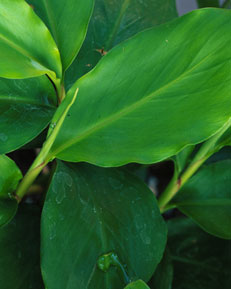 |
Cardamom
Elettaria cardamomum
Family: Zingiberaceae
CTFA Name: Elletaria Cardamomom |
Return to herb list |

Photo © Steven Foster
Introduction
Cardamom is a perennial shrub with thick, fleshy, lateral roots which can grow to a height of 8 feet.1,2 The greenish-yellow seed pods (fruit) which follow the white flowers are harvested, dried, and usually sold whole.1 As a cooking spice, the darker seeds are removed from the seed pod and ground into a powder.3 Cardamom is primarily cultivated in southern India, Sri Lanka, Tanzania, and Guatemala. Guatemala is responsible for the majority of the cardamom production today.1,3 History and Cultural Significance
Historically known as the “Queen of all Spices”,1,3 cardamom has been used in India since ancient times. Scrolls dating back to the Vedic period (3000 BCE) mention the use of this spice in wedding ceremonies.1 It has been implemented as a digestive aid and as a fat reducer according to Ayurvedic (traditional Indian medicine) texts which date back to 1400 BCE.1 Ancient Egyptians used cardamom as a mouth freshener.1 As a spice, cardamom is used in Indian cuisine for curry, coffee, cakes, bread, and flavoring sweet dishes and drinks.1,4 The seed and the essential oil are used as a flavoring component in a variety of foods including alcoholic and non-alcoholic beverages, frozen desserts, candy, baked goods, gelatins, puddings, condiments, relishes, gravies, meat, and meat products. Cardamom has been used in traditional Chinese and Indian medicine as a digestive aid, and for the treatment of intestinal gas.1,2,4 The German Commission E approved the internal use of cardamom for the treatment of indigestion.5 Cardamom has also been added to massage oils and lotions as well as soaps, detergents, and perfumes for its soothing properties.1,4 Modern Research
Currently there are no clinical studies available on the internal or external use of cardamom. Future Outlook
Cardamom is a sustainable export crop for both India and Guatemala with 11,365 and 13,500 tons of cardamom produced respectively from 2001-2002.1 Since cardamom is susceptible to a variety of viral, fungal, bacterial, and nematode diseases, genetic engineering in conjunction with appropriate fertilization and pesticide techniques may be implemented.1 While consumption of cardamom in India, the Middle East, and Scandinavia remains comparatively high, consumption in other developed nations such as the US, Japan,, Australia, New Zealand, and some European nations is still quite low.1 References
1 Ravindran PN, Madhusoodanan KJ, eds. Cardamom: The Genus Elettaria. New York: Taylor and Francis; 2002. 2 Kapoor LD. Handbook of Ayurvedic Medicinal Plants. Boca Raton, FL: CRC Press; 2000. 3 Katzer G. Cardamom Seeds (Elettaria cardamomum). Gernot Katzer’s Spice Pages.1999. Available at: http://www-ang.kfunigraz.ac.at/~katzer/engl/generic_frame.html?Elet_car.html. Accessed April 1, 2005. 4 Leung AY, Foster S, eds. Encyclopedia of Common Natural Ingredients Used in Food, Drugs, and Cosmetics. 2nd edition New York: John Wiley and Sons Inc; 1996. 5 Blumenthal M, Busse WR, Goldberg A, Gruenwald J, Hall T, Riggins CW, Rister RS, eds. Klein S, Rister RS, trans. The Complete German Commission E Monographs¾Therapeutic Guide to Herbal Medicines. Austin, TX: American Botanical Council; Boston: Integrative Medicine Communication; 1998.
|